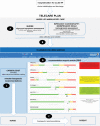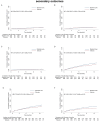Effects of an outpatient intervention comprising nurse-led non-invasive assessments, telemedicine support and remote cardiologists' decisions in patients with heart failure (AMULET study): a randomised controlled trial
- PMID: 34617373
- PMCID: PMC9293217
- DOI: 10.1002/ejhf.2358
Effects of an outpatient intervention comprising nurse-led non-invasive assessments, telemedicine support and remote cardiologists' decisions in patients with heart failure (AMULET study): a randomised controlled trial
Abstract
Aim: Prevention of heart failure (HF) hospitalisations and deaths constitutes a major therapeutic aim in patients with HF. The role of telemedicine in this context remains equivocal. We investigated whether an outpatient telecare based on nurse-led non-invasive assessments supporting remote therapeutic decisions (AMULET telecare) could improve clinical outcomes in patients after an episode of acute HF during 12-month follow-up.
Methods and results: In this prospective randomised controlled trial, patients with HF and left ventricular ejection fraction (LVEF) ≤49%, after an episode of acute HF within the last 6 months, were randomly assigned to receive either an outpatient telecare based on nurse-led non-invasive assessments (n = 300) (AMULET model) or standard care (n = 305). The primary composite outcome of unplanned HF hospitalisation or cardiovascular death occurred in 51 (17.1%) patients in the telecare group and 73 (23.9%) patients in the standard care group up to 12 months after randomization [hazard ratio (HR) 0.69, 95% confidence interval (CI) 0.48-0.99; P = 0.044]. The implementation of AMULET telecare, as compared to standard care, reduced the risk of first unplanned HF hospitalisation (HR 0.62, 95% CI 0.42-0.91; P = 0.015) as well as the risk of total unplanned HF hospitalisations (HR 0.64, 95% CI 0.41-0.99; P = 0.044).There was no difference in cardiovascular mortality between the study groups (HR 1.03, 95% CI 0.54-1.67; P = 0.930).
Conclusions: AMULET telecare as compared to standard care significantly reduced the risk of HF hospitalisation or cardiovascular death during 12-month follow-up among patients with HF and LVEF ≤49% after an episode of acute HF.
Keywords: Ambulatory care; Heart failure; Heart failure hospitalisation; Telecare.
© 2021 The Authors. European Journal of Heart Failure published by John Wiley & Sons Ltd on behalf of European Society of Cardiology.
Figures





Comment in
-
The AMULET ménage à trois: nurse, telemedicine support, and remote cardiologist.Eur J Heart Fail. 2022 Mar;24(3):578-580. doi: 10.1002/ejhf.2437. Epub 2022 Jan 31. Eur J Heart Fail. 2022. PMID: 35060258 No abstract available.
References
-
- Ponikowski P, Voors AA, Anker SD, Bueno H, Cleland JG, Coats AJ, González‐Juanatey JR, Harjola VP, Jankowska EA, Jessup M, Linde C, Nihoyannopoulos P, Parissis JT, Pieske B, Riley JP, Rosano GM, Ruilope LM, Ruschitzka F, Rutten FH, van der Meer P. 2016 ESC Guidelines for the diagnosis and treatment of acute and chronic heart failure: The Task Force for the diagnosis and treatment of acute and chronic heart failure of the European Society of Cardiology (ESC). Developed with the special contribution of the Heart Failure Association (HFA) of the ESC. Eur J Heart Fail 2016;18:891–975. - PubMed
-
- Tromp J, Ferreira JP, Janwanishstaporn S, Shah M, Greenberg B, Zannad F, Lam CSP. Heart failure around the world. Eur J Heart Fail 2019;21:1187–1196. - PubMed
-
- Rubio‐Gracia J, Demissei BG, Ter Maaten JM, Cleland JG, O'Connor CM, Metra M, Ponikowski P, Teerlink JR, Cotter G, Davison BA, Givertz MM, Bloomfield DM, Dittrich H, Damman K, Pérez‐Calvo JI, Voors AA. Prevalence, predictors and clinical outcome of residual congestion in acute decompensated heart failure. Int J Cardiol 2018;258:185–191. - PubMed
-
- Butt JH, Fosbøl EL, Gerds TA, Andersson C, McMurray JJV, Petrie MC, Gustafsson F, Madelaire C, Kristensen SL, Gislason GH, Torp‐Pedersen C, Køber L, Schou M. Readmission and death in patients admitted with new‐onset versus worsening of chronic heart failure: insights from a nationwide cohort. Eur J Heart Fail 2020;22:1777–1785. - PubMed
Publication types
MeSH terms
LinkOut - more resources
Full Text Sources
Medical
Research Materials
Miscellaneous

